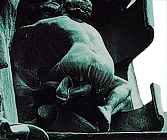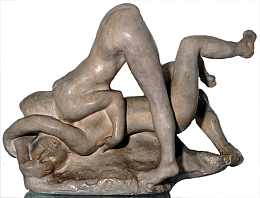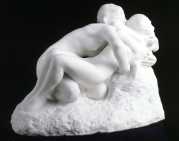|
 We
find an early version the 'Damned Women' on the right pilaster of
'The Gates of Hell', embracing each other with lesbian passion - which by
the time of Dante as well as during Rodin's life was generally
considered a capital sin, or at least a severe psycho-social aberration. We
find an early version the 'Damned Women' on the right pilaster of
'The Gates of Hell', embracing each other with lesbian passion - which by
the time of Dante as well as during Rodin's life was generally
considered a capital sin, or at least a severe psycho-social aberration.
The poet Charles Baudelaire, who greatly influenced and
inspired Rodin with his 'Fleurs du mal', wrote the following lines
about the unsatiable lust of the femmes damnées:
You that in your hell my soul pursues,
For your dejected sorrows, your thirsts unslakeable,
Poor sisters, I love as much as I pity you,
For the urns of love with which your large hearts are full!
 Rodin worked out the subject in several variations - in
fact, all the women populating the crowded tympanum were damned in one way
or another, so that 'The Caryatid', for
example, was also known as 'A damned woman from Dante's Hell'. Rodin worked out the subject in several variations - in
fact, all the women populating the crowded tympanum were damned in one way
or another, so that 'The Caryatid', for
example, was also known as 'A damned woman from Dante's Hell'.
'The Metamorphoses of Ovid' (ca. 1884) is another
denomination for
the same presentation of female homosexuality, now ennobled by the
reference to the great Roman poet, who had deplored the decadence
following mankind's 'Golden Age', and - in this exquisite stone carving from the Helsinki Museum - by the pure whiteness of the marble.
Other titles assigned to the same composition are 'Flowers of evil'
(directly referring to Baudelaire's poetry), 'Death and the maiden', and
'Gemini, Castor and Pollux' (switching the sex of the characters, like in 'Kneeling
Fauness'/ 'Orpheus and the Furies'). On
a photograph of a vertically arranged version, Rodin wrote 'Le désir'
('Desire').
exquisite stone carving from the Helsinki Museum - by the pure whiteness of the marble.
Other titles assigned to the same composition are 'Flowers of evil'
(directly referring to Baudelaire's poetry), 'Death and the maiden', and
'Gemini, Castor and Pollux' (switching the sex of the characters, like in 'Kneeling
Fauness'/ 'Orpheus and the Furies'). On
a photograph of a vertically arranged version, Rodin wrote 'Le désir'
('Desire').
|
 We
find an early version the 'Damned Women' on the right pilaster of
'The Gates of Hell', embracing each other with lesbian passion - which by
the time of Dante as well as during Rodin's life was generally
considered a capital sin, or at least a severe psycho-social aberration.
We
find an early version the 'Damned Women' on the right pilaster of
'The Gates of Hell', embracing each other with lesbian passion - which by
the time of Dante as well as during Rodin's life was generally
considered a capital sin, or at least a severe psycho-social aberration.
 Rodin worked out the subject in several variations - in
fact, all the women populating the crowded tympanum were damned in one way
or another, so that
Rodin worked out the subject in several variations - in
fact, all the women populating the crowded tympanum were damned in one way
or another, so that 